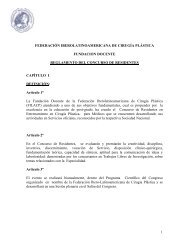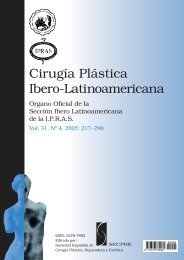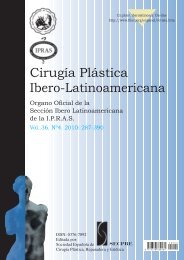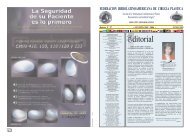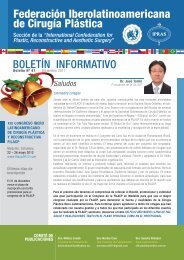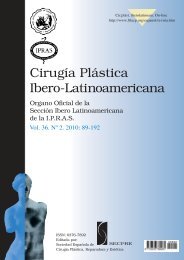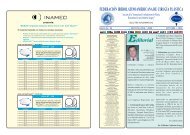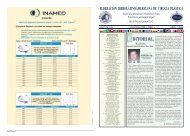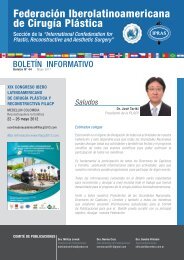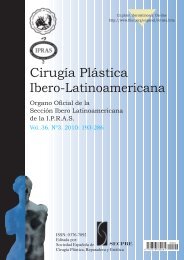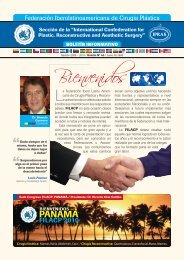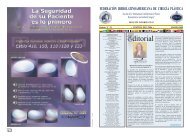CirugÃa Plástica Ibero-Latinoamericana - Planetec
CirugÃa Plástica Ibero-Latinoamericana - Planetec
CirugÃa Plástica Ibero-Latinoamericana - Planetec
You also want an ePaper? Increase the reach of your titles
YUMPU automatically turns print PDFs into web optimized ePapers that Google loves.
CIRUGÍA PLÁSTICA IBERO-LATINOAMERICANA<br />
Cir.plást. iberolatinoam.-Vol. 38 - Nº 1<br />
Enero - Febrero - Marzo 2012 / Pag. 9-26<br />
Mamoplastia de aumento secundaria.<br />
Evaluación de problemas, resultados<br />
insatisfactorios y alternativas de solución<br />
Secundary augmentation mammoplasty. Evaluation of problems,<br />
unsatisfactory results and alternatives for solution<br />
Berrocal Revueltas, M.*<br />
Berrocal Revueltas, M.<br />
Resumen<br />
Abstract<br />
Presentamos un resumen de pacientes con resultados insatisfactorios<br />
tras mamoplastia de aumento con implantes de silicona con el objetivo<br />
de identificar los factores asociados que permitan ayudar a<br />
identificar los problemas más frecuentes en este tipo de cirugía y ofrecer<br />
alternativas de solución.<br />
De un grupo universal de 230 paciente intervenidas quirúrgicamente<br />
por mamoplastia de aumento entre 2004 y 2009, presentamos<br />
un grupo de 15, de las cuales 12 habían sido intervenidas por primera<br />
vez por otro equipo médico y 3 por el primer autor del trabajo. De ellas,<br />
13 tuvieron que ser sometidas a mamoplastia secundaria para corrección<br />
de problemas con resultados muy satisfactorios tras un año de<br />
postoperatorio. Sin embargo, 2 pacientes presentaron como problema<br />
inicial estrías mamarias en el postoperatorio inmediato que no han tenido<br />
solución definitiva hasta el momento.<br />
Las posibles causas de los problemas surgidos tras la mamoplastia<br />
primaria fueron: vía de acceso inadecuada o no indicada en el 60%<br />
de los casos; volumen excesivo de los implantes en el 80% de los casos<br />
(12 pacientes), de las cuales 10 solicitaron implantes de menor volumen<br />
y 2 rehusaron la colocación de nuevos implantes; rotura de los implantes<br />
antes del primer año de postoperatorio en 2 pacientes (13.3%)<br />
y rotura a los 25 años de postoperatorio en 1 paciente; contractura capsular<br />
asintomática grado I y II en 12 pacientes (80% de los casos) y de<br />
grado III en 3 pacientes (20%).<br />
Respecto al certificado de garantía de los implantes, 10 pacientes<br />
(66%) no tenían información alguna referente a la importancia del<br />
mismo y no encontramos información del fabricante en los implantes<br />
retirados en 6 pacientes (40%).<br />
Como conclusión, observamos un vacio en cuanto a la unidad de<br />
criterios a la hora de encarar los problemas secundarios a la mamoplastia<br />
de aumento con prótesis de silicona y, se hace evidente la necesidad<br />
de fomentar estudios con alto nivel de evidencia en las<br />
universidades, sociedades científicas y organismos gubernamentales,<br />
que permitan cuantificar las secuelas de este tipo de cirugía para clasificarlas<br />
y ofrecer alternativas de solución a las mismas.<br />
Palabras clave<br />
Mamoplastia de aumento,<br />
Implantes de silicona, Prótesis<br />
mamarias, Secuelas cirugía mamaria.<br />
Código numérico 5211-52114-52115<br />
A series of patients with unsatisfactory results after a breast augmentation<br />
surgery with silicone implants is presented in this report.<br />
The aim is to identify the most frequent problems and to offer alternatives<br />
for their solution.<br />
From an universal group of 230 patients with aesthetic breast augmentation<br />
surgery done from 2004 to 2009, a selective group of 15<br />
patients is presented; out of these, 12 had a surgical procedure done<br />
for the first time by another medical team and 3 done by the first author<br />
of this paper. After medical evaluation 13 patients had a secondary<br />
breast augmentation surgery in order to correct the problems with<br />
satisfactory results one year postoperative. Nevertheless, 2 patients<br />
had breast stretch marks as first problem in the postoperative period<br />
which does not have a definitive solution by now.<br />
The possible reasons of the problems are: inadequate or not indicated<br />
line of access in 60%; implant size was excessive in 12 patients<br />
(80%), out of these, 10 patients requested implants with smaller size<br />
and 2 did not agree to get new implants; 2 patients (13.3%) suffered<br />
implant rupture before the first postoperative year and 1 patient had<br />
rupture after 25 years of the surgical procedure; in 12 patients (80%)<br />
there was asymptomatic capsular contracture grade I and II and grade<br />
III in 3 patients (20%).<br />
There was no information about the manufacturer of the implants<br />
in 6 patients (40%) and 10 patients (66%) did not have any information<br />
about the importance of having a certificate of guarantee on the<br />
implants.<br />
We conclude that there is a lack of unified criteria to face the secondary<br />
problems after breast augmentation surgery using silicone<br />
implants, therefore it is necessary to encourage scientific studies by<br />
universities, professional societies and governmental agencies in order<br />
to quantify sequels, classify them and offer alternatives for their solution.<br />
Key words<br />
Augmentative mammoplasty, Silicone<br />
breast implants, Mammary implants,<br />
Mammoplasty sequels.<br />
Numeral Code 5211-52114-52115<br />
* Especialista en Cirugía Plástica, Reparadora y Estética. Profesora Titular de Cirugía Plástica, Facultad de Medicina, Universidad de<br />
Cartagena. Cartagena de Indias, Colombia.



